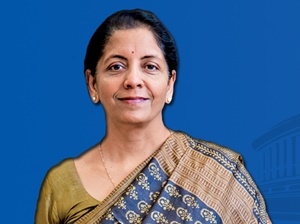Budget 2020-21 aims at `Ease of Living', spurring growth
01 Feb 2020
Finance minister Nirmala Sitharaman today presented the union budget for fiscal 2020-21, which, she said, aims to boost incomes and purchasing power of the common man that, in turn, would help grow demand and thereby revive economic growth that has fallen to levels below 5 per cent.

Budget 2020-21, interwoven around themes of Aspirational India, Economic Development and a caring society, aims to achieve seamless delivery of services, improve physical quality of life, mitigate disaster risks and boost social security.
"Our Prime Minister has laid before us Ease of Living as a goal to be achieved on behalf of all citizens", said the union minister for finance and corporate affairs Nirmala Sitharaman while presenting the Union Budget 2020-21 in Parliament today. With this backdrop, our government shall work towards taking the country forward so that we can leapfrog to the next level of health, prosperity and wellbeing, she said.
Official estimates put India's economic growth in the current fiscal ending 31 March 2020 to be around 5 per cent, the slowest since the global financial crisis of 2008-09.
The budget is set in the backdrop of proliferation of cutting edge technologies, highest ever cohort of productive age population; ideas of corruption-free and policy-driven good governance and clean and a sound financial sector.
The government, Nirmala Sitaraman said, is committed to substantially boost investment in agriculture, infrastructure, social sector, education and health.
Economic development for all, indicated in the prime minister's exhortation of "Sabka Saath, Sabka Vikas, Sabka Vishwas" entails pervasive economic reforms and yielding more space for the private sector to ensure higher productivity and greater efficiency. Government sees the three components of this as industry, commerce and investment; Infrastructure and the New Economy.
A Caring Society, based on `Antyodaya', which is both humane and compassionate, the components of which are women and child, social welfare; culture and tourism and environment and climate change.
These three broad themes are held together by a corruption-free, policy-driven good governance and a clean and sound financial sector.
The finance minister further said that this budget is being presented in the backdrop of two cross-cutting developments namely, proliferation of technologies like Machine Learning, Robotics, AI, Analytics, Bio-Informatics; and the highest ever cohort of productive age population (15-65 years). Consequently, the digital revolution has placed India in a unique leadership position globally. The government aims to:
- Achieve seamless delivery of services through digital governance;
- Improve physical quality of life through National Infrastructure Pipeline;
- Mitigate risks through disaster resilience; and
- Boost social security through pension and insurance penetration.
The finance minister also said that the Union Budget 2020-21 reflects the government's firm commitment to substantially boost investment in agriculture, infrastructure, social sector, education and health. This is substantiated by increase in expenditure of Rs3,43,678 crore over revised estimates for 2019-20 while keeping the fiscal deficit at 3.8 per cent of GDP, she said.
These are the initial highlights from Sitharaman's fiscal 2020-21 budget speech:
- Agriculture and allied activities allocated Rs2,83,000 crore for 2020-21;
- Rs3,60,000 crore allocated for new central water scheme;
- Education sector to get Rs99,300 crore allocation in 2020-21;
- Taxes from medical devices to be used to fund healthcare infrastructure;
- Allocate Rs69,000 crore toward healthcare spending;
- Schemes to boost manufacture of mobile phones, electronic equipment and semiconductor packaging;
- Milk processing capacity to be doubled by 2025;
On the infrastructure side, the finance minister said 100 more airports will be developed by 2024 to support the UDAN scheme. She said Rs 1,70,000 crore has been provided for transport infrastructure in 2020-21. She also said 150 trains will run under the public private partnership (PPP) mode, also four stations will be redeveloped with the help of the private sector.
More semi-high-speed Tejas-like trains will be set up between major tourist destinations, Finance minister Sitharaman said in her budget speech. Tejas Express is India's first train with fully automated features which currently runs between Delhi and Lucknow. The finance minister also announced more high speed trains like the one between Ahmedabad and Mumbai.
To improve the efficiency of ports in the country, the government will set up a framework and look at corporatisation of at least one major port followed by subsequent listing on stock exchanges..Sitharaman said the performance of ports have improved and government is taking steps to further enhance their efficiency. "Sea ports have improved... government will come out with a framework for ports and will look into corporatising at least one major port and subsequently its listing on stock exchanges," Sitharaman said. Major ports in the country have an installed capacity of 1,514.09 million tonnes per annum as of March 2019 and handled traffic of 699.09 million tonnes during 2018-19.







.webp)














